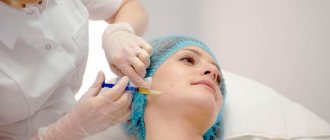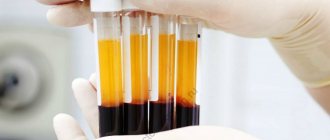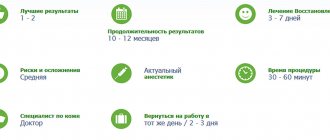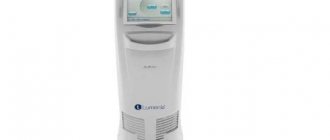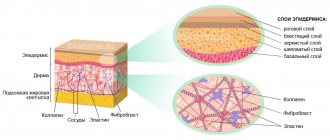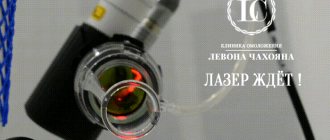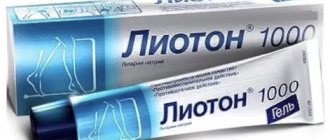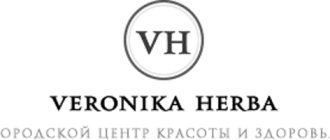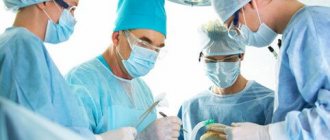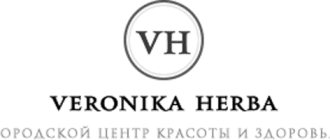“Modern development of technology has accustomed most of us to the idea that laser can quickly and efficiently correct anything - scars, moles, wrinkles, and keloid scars after surgery.
Therefore, during appointments I am often asked the same question: is it possible to permanently remove keloids using a laser?
Yes, laser is used to correct keloids. But, as they say, there is a nuance.”
Maxim Vasiliev, plastic surgeon, expert in the treatment of keloid scars.
Hypertrophic scars respond very well to lasers. Unfortunately, keloids are unusual scars.
The fact is that keloids are one of the most intractable problems in medicine. It consists of clumps of randomly growing connective tissue. An ordinary scar can be “evaporated” with a laser. But an unprepared keloid will almost always begin to grow after laser exposure, and more actively than before.
However, laser therapy for keloid scars is in the hands of specialists and brings beautiful results. There are only some conditions that must be strictly observed
.
There are several types of hardened scars:
- Normotrophic. This is the classic picture of healed tissue. They are pale and do not stand out above the skin.
- Keloids. Usually bluish or bright pink in color, stand out above the surface of the skin, often lumpy. These scars occur after an emergency caesarean section or any other emergency surgery on the chest or near the groin area. In this case, laser scar removal requires more procedures and sometimes drug therapy.
- Atrophic. The scars are slightly retracted into the skin and can be either flesh-colored or bluish in color. A striking example is post-acne marks, stagnant spots, stretch marks.
- Hypertrophic. These are dense scars that rise above the skin, usually pinkish in color, but lighten over time. Often occur at the site of burns and deep lacerations.
Laser resurfacing, which our clinic in North-West Administrative District offers, treats all types of scars, but some of them cannot be completely removed: they can only be smoothed out or lightened.
Patient age
Removing marks after injuries in adulthood is much more difficult than for young people. This is due to the fact that the elasticity of the skin gradually decreases. Therefore, it will take a lot of effort to build up a healthy appearance and provoke the growth of fibroblasts using a laser. It will take a long time to cope with old scars.
For the purpose of blepharoplasty, laser resurfacing is performed at any age. They do it to rejuvenate, reduce skin sagging, and reduce wrinkles. The procedure takes place without surgical intervention, and this makes it safe. The main thing is to find a specialized specialist with high-quality equipment.
How does laser scar removal work?
Laser scar removal is a procedure that will reduce the depth of any scar and lighten it. The laser seems to grind down the upper layers of the skin, removing dense scar tissue, and evens out the boundaries between healthy skin and new dermis. In its place, collagen and elastin are actively formed, a normal healthy skin structure is formed, so this service is recommended to everyone who has deep scars.
Before the procedure, you should wait about six months until the inflammatory process passes, the redness in the scar area subsides, and the suture, if any, heals properly. Otherwise, scar tissue may grow.
Duration of scar formation
Laser scar resurfacing can be done after natural healing of the wound: this period lasts from 3-6 months. Treatment should begin with special creams and gels, and after six months it is allowed to switch to hardware therapy. The recovery process becomes more difficult after one year.
In practice, atrophic and keloid changes are the most difficult to cope with: in the latter case, surgical removal of excess tissue may be required.
Laser resurfacing includes several stages:
- Preparing for the procedure. 2-3 weeks before the correction, the patient must pass the necessary tests (biochemistry, HIV, hepatitis and general blood test), undergo a chemical peeling procedure and take antiviral drugs prescribed by the doctor. In some cases, these drugs are also taken after resurfacing.
- Preparing for the procedure. Since removal is accompanied by unpleasant sensations and tingling in the scar area, the clinic may administer local anesthesia. In some cases, the patient is prescribed sedatives.
- Operation of the device. The doctor directs the laser to the treated area and turns it on. A stream of air is applied to the scar to cool the skin. Resurfacing lasts on average 20 minutes, but depending on the area and depth of the scar, this time can be increased to 2 hours per session.
- Treating the scar with special ointments and solutions. After this, the patient can go home.
- Rehabilitation lasts from a week to three. During this time, the patient must follow the doctor’s instructions, change the bandage with medicinal ointments in a timely manner, do not apply makeup for the first time and avoid contact of the treated area with water and cleansers.
When is the best time to start laser treatment?
Laser scar resurfacing can be done on any part of the body: face, décolleté, neck, legs, arms, abdomen, back.
The session takes place only after the site has been examined. To do this, palpation and exchange of information between the patient and the cosmetologist are carried out. The specialist must know the cause of the skin pathology, evaluate the client for possible contraindications, and only then prescribe the procedure. The size and depth of the laser beam, as well as the vibration frequency, are selected separately. As a result, after proper hardware treatment, scar tissue is destroyed and new elastic, smooth skin is formed.
If you contact a professional cosmetologist, you can remove the scar with laser within one year.
Benefits of Laser Scar Removal
- Point impact. The doctor adjusts the device in such a way as to optimize the depth of laser penetration into the skin and minimize the risk of injuring the healthy dermis.
- The most gentle effect on the skin. Setting the laser to a micron will reduce the rehabilitation period after correction; the beam gently treats the skin without causing discomfort to the patient.
- Short duration of the procedure. On average, the correction lasts 20 minutes.
- General improvement in skin condition. Since the laser beam sterilizes the scar area, the patient observes general improvements: narrowing of pores, improved complexion, increased skin elasticity.
Our cosmetology and dermatology clinic “BL” is pleased to offer you a service - laser scar resurfacing, prices for which can be found by making an appointment with us. Our specialist will review your application and calculate the cost for the full course of procedures. But for a more accurate calculation, an in-person consultation with a cosmetologist is necessary.
Presence of contraindications
The session is scheduled after a conversation with the patient, when the degree of risk is determined. But in most cases, laser scar resurfacing can be done if contraindications are met:
- no pregnancy;
- the infant is not fed;
- blood clotting is not impaired;
- no skin diseases - psoriasis, eczema, vitiligo, dermatitis;
- no diabetes mellitus;
- pressure does not increase.
The procedure is also contraindicated for scleroderma and collagenosis.
Scars and scars. Doctor I
Post-acne correction techniques
Before the era of laser technology, there was no effective and safe treatment for acne scars. In order to correct them, deep peelings were used, which often resulted in burns, continuous scarring of the treated area and a questionable aesthetic result 2, 3.
Currently, the most effective, fast and safe method of treating atrophic post-acne scars is the use of DOT and DROT therapy using the SmartXide2 from DEKA (Italy).
The advantages of this technique include not only the combination of a CO2 laser with RF radiation, but also the ability to modulate the pulse shape and the presence of five levels of stacks (patented technology from DEKA).
The effectiveness of treatment of scar tissue with the SmartXide2 laser device consists of the following factors:
- Point fractional vaporization of microscopic areas of the skin occurs at a strictly specified depth, which leads to a reduction in the area of the treated area, the formation of tissue heating zones (in undamaged areas of the skin) and, as a result, active stimulation of new collagen.
- When using DROT therapy, the initial effect on the tissue is made by a CO2 laser pulse, preparing the skin for subsequent exposure to RF radiation by increasing blood flow in the dermis, as a result of which its conductivity for thermal energy significantly increases. Subsequent RF radiation, penetrating deeply into the dermis, can provide intense and long-term stimulation of fibroblasts without damaging the skin. It is noted that even when choosing higher parameters of laser energy when using combined (DROT) therapy, an increase in the recovery period is not typical.
- For laser therapy of post-acne scars, the depth of penetration of the laser beam and the ability to flexibly change this parameter are fundamentally important. SmartXide2 allows, due to the stacking mode from 1 to 5 levels, to adjust the depth of exposure without pronounced lateral thermal damage, making it possible to carry out highly effective and differentiated laser therapy for scars with minimal risk of side effects, even when using high laser energy parameters.
- An undeniable advantage in working with scars is the ability to modulate the pulse shape. In particular, when working with deep atrophic scars and thick porous skin, the D-Pulse pulse shape is preferred. This form of pulse has a high peak power, which does not depend on the subsequent thermal part, which makes it possible to achieve pronounced tissue shrinkage and leveling of its relief.
It must be especially emphasized that the basis for the effectiveness of this laser is a combination of parameters: modulation of the pulse shape, adjustable depth of impact (stacks) and adjustable distance between points, which provides doctors with effective opportunities to control the nature of the impact, individualize therapy and avoid the occurrence of excessive thermal damage to the lateral zones, which directly reduces the risk of post-inflammatory hyperpigmentation. This is especially relevant when treating scars in patients with skin phototype III and higher.
In addition to the general standard contraindications for laser therapy, special attention should be paid to patients receiving oral retinoid treatment for the treatment of acne. When taking them, thinning of the skin, the occurrence of hypersensitivity (including to solar radiation), impaired cell differentiation, and slower repair may be observed. Therefore, in this category of patients, laser therapy for post-acne scars is contraindicated for use during the entire period of drug therapy and 6 months after it in order to prevent the occurrence of dyschromia and pathological scarring.
Prices
| Body | Face | Eyelids | Anesthesia + consumables |
| up to 1 cm | from 8,000 rub. | from 9,000 rub. | |
| up to 2 cm | from 10,000 rub. | from 10,000 rub. | |
| up to 3 cm | from 12,000 rub. | from 15,000 rub. | |
| up to 5 cm | from 15,000 rub. | from 19,000 rub. | + 1,500 rub. |
| up to 7 cm | from 12,000 rub. | from 19,000 rub. | |
| up to 9 cm | from 12,000 rub. | from 25,000 rub. | + 3,000 rub. |
| up to 15 cm | from 20,000 rub. | + 4,000 rub. |
| Plastic surgery with a displaced flap | Graft collection | |
| up to 3 cm | from 10,000 rub. | |
| up to 5 cm | from 20,000 rub. | from 15,000 rub. |
| up to 7 cm | from 25,000 rub. | from 20,000 rub. |
| up to 9 cm | from 30,000 rub. | |
| Scar cutting | |
| (one to 1 cm) | 6,000 rub. |
| (one to 3 cm) | 8,000 rub. |
| Absorbable injections | |
| (diprospan) 0.5 ml | 1,500 rub. |
| (diprospan) 1 ml | 2,000 rub. |
RUB 30,000 - cutting of nasolabial folds
1,000 rub. — anesthesia + consumables
The Medial Clinic guarantees patients comfort and speed of procedures. To make an appointment with us, call: +7 (499) 137-00-00.
Rehabilitation after the procedure
The rules and requirements of the rehabilitation period are voiced by the cosmetologist who performed the manipulations. By following the principles of rehabilitation, it will be possible to avoid side effects and consolidate the results of therapy.
Mandatory recommendations during recovery are as follows:
- Under no circumstances should you peel off the crusts that have formed at the site of the removed scar. They will fall off on their own in 3-4 days. It is also forbidden to scratch or rub the treated area.
- Refuse to visit the sauna, bathhouse, solarium, swimming pool. In the first days after the procedure, the skin is sensitive and prone to inflammation. Therefore, it is important to provide her with peace and not expose her to unnecessary stress.
- Regularly use skincare products prescribed by a specialist. After laser scar removal, the cosmetologist will individually select a wound-healing and restorative cream, taking into account skin type, depth of laser exposure and other important factors.
- Protect treated areas from direct sunlight. Before going outside, you need to lubricate your skin with sunscreen and wear clothes that will protect you from ultraviolet radiation.
Possible side effects and negative consequences
Complications after laser scar removal are rare and are mainly associated with non-compliance with the rules of the rehabilitation period. Most often, clients encounter the following side effects:
- Erythema. It may appear 1.5 - 2 weeks after therapy and disappears on its own after 3 - 4 months. Manifests itself in the form of inflammation and redness of the skin.
- Pigmentation disorders. There are 2 types of pigmentation disorders - hyper- and hypopigmentation. The first type occurs more often in people with dark skin. Hypopigmentation is a sign of local death of melanocytes.
- Scarring. It may occur due to improper skin care during the rehabilitation period or due to non-compliance with the grinding technology by the cosmetologist.
- Infection. A rare complication that develops against the background of the spread of an infection that, before laser resurfacing, sat deep in the pores of the dermis, and after thermal exposure was activated and began to actively multiply.
What lasers are used for resurfacing?
For example, erbium. This is when a laser beam heats pigments in the skin and destroys the structures that contain these pigments, but at the same time the surrounding tissue remains intact. This technology is effective for removing age spots and vascular defects, but is ineffective for rejuvenation.
Lasers operating on a fractional principle are better suited for rejuvenation. First of all, this is the American Fraxel (Fraxel). It also copes well with all skin blemishes.
